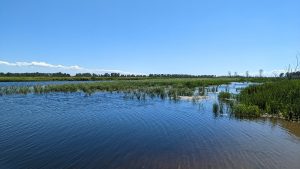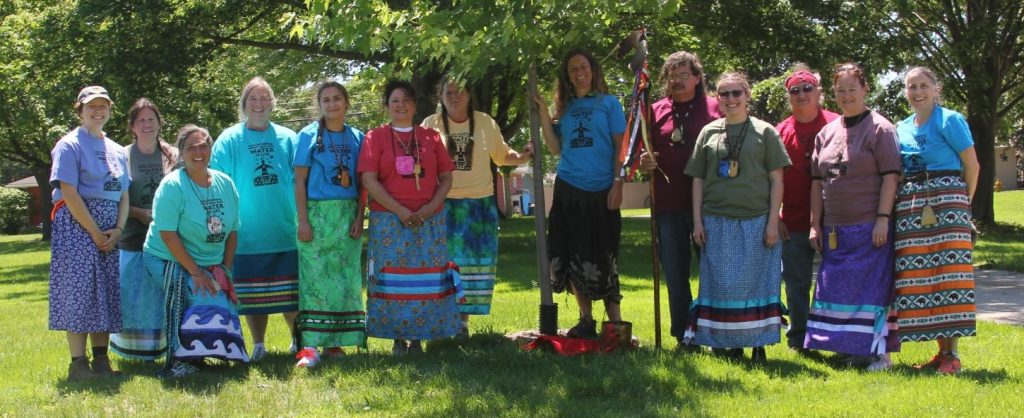As the largest lake entirely within Wisconsin’s borders, Lake Winnebago spans nearly 132,000 acres across three counties. Fed by the Wolf and Fox rivers, it’s a place rich in significance for several tribal nations, including the Ho-Chunk, Meskwaki, Fox, Sauk, Menominee, Oneida, Stockbridge-Munsee, Brothertown and others.
It is this importance to multiple nations that led Mark Denning (Oneida/Menominee) to describe Lake Winnebago and its tributaries as “international waters.” Said Jessica Ryan, vice chair of the Brothertown Indian Nation, who recounted hearing this comment from Denning, “That (statement) really stuck out to us… We know that all these nations have called these waterways home, but that was really impactful. This is how all the trading happened, and the water sustained us. It’s the lifeblood of Earth.”
Ryan is part of a team working on an effort known as the Lake Winnebago InterTribal Connectivity Project, which is receiving Wisconsin Sea Grant support during Sea Grant’s 2022-24 research funding cycle. Her partners in this work include Dr. Jessie Conaway of the University of Wisconsin-Madison; Skip Blanc, a Brothertown tribal council member; and other members of the Brothertown Nation. They are joined by a vast network of partners from other Native nations, UW-Madison students, non-tribal partners, and agencies like the U.S. Fish and Wildlife Service. This large, multifaceted collaborative is focusing on revitalizing wild rice in the Lake Winnebago area.

Wild rice grows in a coastal wetland in Peshtigo, Wisconsin, in summer 2022. A collaborative effort supported in part by Wisconsin Sea Grant will consider wild rice revitalization at Lake Winnebago. (Photo: Titus Seilheimer)
While still present, particularly in Lake Poygan (just west of Lake Winnebago), wild rice is not what it used to be in the area. Ryan recounted coming across an old journal that described Lake Winnebago as “teeming with rice such that the boats could not pass.” That vivid image stuck in her mind due to its disconnect with current reality.
Project work will include assessing water quality, sediments and wild rice habitat. Said Blanc of the wide-ranging effort, “It’s going to take all of us, Native and non-native, from all spectrums of life to do this.”
Building a network, looking ahead
Ryan and the UW’s Conaway first met back in 2015 and had kept in touch. The current work on Lake Winnebago got off the ground in 2019, in part due to help from Ashley Gries, a UW graduate student at the time. “Students can really be the engines of our work and very inspirational,” said Conaway.
In 2021, the Brothertown Nation, Conaway and Gries formed a strategy and invited 12 tribal nations to come together to discuss wild rice work and Lake Winnebago; eight were able to attend. Sea Grant support began in 2022 to help keep this effort moving forward.
Gries described wild rice as a “persnickety plant” that is sensitive to environmental changes. She sees water levels, water quality, nutrient loading, sedimentation and possible user conflicts as just some of the facets for the collaboration to consider. The team will need to weigh appropriate locations for reseeding plants.

Participants in the 2022 Lake Winnebago Water Walk draw attention to water as a vital, precious resource. All are welcome at the event coordinated by the Brothertown Indian Nation, whose vice chair, Jessica Ryan, is pictured third from the left. Ryan is also a key organizer for the Lake Winnebago InterTribal Connectivity Project.
The project will take a long view, considering not only what is feasible given current conditions and uses of the lake, but also what would be sustainable over many years to come.
“I want to see the rice restored, but I don’t know if that’s practical; I don’t know if it can be done long-term,” said Ryan. Yet it is a cherished goal given the cultural importance of wild rice to many peoples (and also its importance to other living beings that depend on it).
Conaway stressed the need to organize around conservation and tribal priorities. “This area is rich with history, stories and connections. It’s a large project, and it can feel unwieldy, but we know we’re on a good path… and I’m grateful for the opportunity. We’re in it for the long haul,” she said.
The Lake Winnebago InterTribal Connectivity Project will bring together resources, equipment and knowledge from its many partners to learn as much as possible and consider future plans. To learn more, contact Jessie Conaway at jessie.conaway@wisc.edu.





